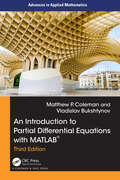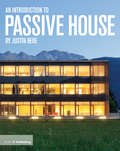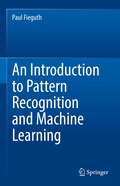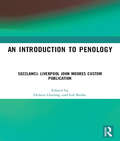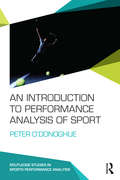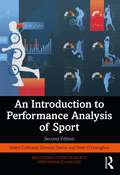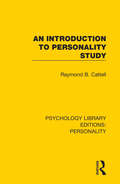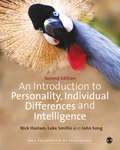- Table View
- List View
An Introduction to Partial Differential Equations with MATLAB (ISSN #27)
by Matthew P. Coleman Vladislav BukshtynovThe first two editions of An Introduction to Partial Differential Equations with MATLAB® gained popularity among instructors and students at various universities throughout the world. Plain mathematical language is used in a friendly manner to provide a basic introduction to partial differential equations (PDEs).Suitable for a one- or two-semester introduction to PDEs and Fourier series, the book strives to provide physical, mathematical, and historical motivation for each topic. Equations are studied based on method of solution, rather than on type of equation.This third edition of this popular textbook updates the structure of the book by increasing the role of the computational portion, compared to previous editions. The redesigned content will be extremely useful for students of mathematics, physics, and engineering who would like to focus on the practical aspects of the study of PDEs, without sacrificing mathematical rigor. The authors have maintained flexibility in the order of topics.In addition, students will be able to use what they have learned in some later courses (for example, courses in numerical analysis, optimization, and PDE-based programming). Included in this new edition is a substantial amount of material on reviewing computational methods for solving ODEs (symbolically and numerically), visualizing solutions of PDEs, using MATLAB®'s symbolic programming toolbox, and applying various schemes from numerical analysis, along with suggestions for topics of course projects.Students will use sample MATLAB® or Python codes available online for their practical experiments and for completing computational lab assignments and course projects.
An Introduction to Passive House
by Justin BereThroughout the world, Passive House is now recognised as the best method to create comfortable, healthy, low energy buildings and it is a key component of the 21st century's green economic revolution. Written by one of the UK's leading passive house architects, this book contains essays that reveal the technical and creative secrets of Passive House design, as well as containing case studies of some of the world's best examples of beautiful, technically excellent buildings that still feel great even when the power supply is turned down to almost nothing. Whether you are an architect, client, student or construction professional, this book is an enlightening introduction to Passive House and a valuable source of inspiration.
An Introduction to Pattern Recognition and Machine Learning
by Paul FieguthThe domains of Pattern Recognition and Machine Learning have experienced exceptional interest and growth, however the overwhelming number of methods and applications can make the fields seem bewildering. This text offers an accessible and conceptually rich introduction, a solid mathematical development emphasizing simplicity and intuition. Students beginning to explore pattern recognition do not need a suite of mathematically advanced methods or complicated computational libraries to understand and appreciate pattern recognition; rather the fundamental concepts and insights, eminently teachable at the undergraduate level, motivate this text. This book provides methods of analysis that the reader can realistically undertake on their own, supported by real-world examples, case-studies, and worked numerical / computational studies.
An Introduction to Penology - LJMU Custom Publication: Essential Reading (level 5)
by Helena Gosling; Lol BurkeThis book encourages criminology students to critically engage with both longstanding and emerging penological debates, taking into consideration the theory, policy and practice which surrounds both custodial and community interventions.
An Introduction to Penology: Punishment, Prisons and Probation
by Lawrence Burke Helena goslingAn Introduction to Penology is a concise, informative, scholarly guide that will speak to a variety of audiences interested in how the notion of punishment plays out in community and custodial settings with people who have broken the law. With a particular focus on prisons and probation, the book provides an opportunity for readers to critically engage with the concept of punishment (in theory and practice) and consider different ways in which we, as a society, can respond to lawbreaking. The text will allow students to pursue a more in-depth study of two of the main criminal justice institutions through the lens of their organisational structures, cultures, service delivery and responses to the needs of minority and vulnerable groups. Throughout the text, students will be encouraged to critically engage with longstanding penological debates taking into consideration the theory, policy and practice of punishment, and will explore ways in which we can rethink penology on an individual and social level and begin to make a case for social justice rather than criminal justice. This innovative and contemporary text is a must read for students studying criminology, criminal justice, penology and those interested in pursuing a career in either the prison or probation services. Lol Burke is Professor in Criminal Justice and Dr Helena Gosling is a Senior Lecturer in Criminal Justice at Liverpool John Moores University.
An Introduction to Penology: Punishment, Prisons and Probation
by Lawrence Burke Helena goslingAn Introduction to Penology is a concise, informative, scholarly guide that will speak to a variety of audiences interested in how the notion of punishment plays out in community and custodial settings with people who have broken the law. With a particular focus on prisons and probation, the book provides an opportunity for readers to critically engage with the concept of punishment (in theory and practice) and consider different ways in which we, as a society, can respond to lawbreaking. The text will allow students to pursue a more in-depth study of two of the main criminal justice institutions through the lens of their organisational structures, cultures, service delivery and responses to the needs of minority and vulnerable groups. Throughout the text, students will be encouraged to critically engage with longstanding penological debates taking into consideration the theory, policy and practice of punishment, and will explore ways in which we can rethink penology on an individual and social level and begin to make a case for social justice rather than criminal justice. This innovative and contemporary text is a must read for students studying criminology, criminal justice, penology and those interested in pursuing a career in either the prison or probation services. Lol Burke is Professor in Criminal Justice and Dr Helena Gosling is a Senior Lecturer in Criminal Justice at Liverpool John Moores University.
An Introduction to Pentecostalism
by Allan Heaton AndersonPentecostalism has become the fastest growing Christian movement, particularly outside Europe, and Allan Heaton Anderson is one of the foremost scholars of this phenomenon. His innovative interpretation of Pentecostalism focuses on the serious contribution made by both western and Majority World participants in its development. In this second edition of his leading introductory course book, Anderson presents an updated global history of the movement, which addresses significant events and changes in recent years, and surveys important theoretical issues such as gender and society, as well as politics and economics. The book also offers a comprehensive explanation of the significance of Charismatic Christianity throughout the world, plus its effect upon the globalisation of religion and its transformation in the present century. This new edition will be an important resource for those studying Pentecostalism, Charismatic Christianity, theology and sociology of religion.
An Introduction to Performance Analysis of Sport (Routledge Studies in Sports Performance Analysis #6)
by Peter O'DonoghuePerformance analysis has become an essential tool for coaches, athletes, sports organisations and academic researchers. Collecting and interpreting performance data enables coaches to improve their training programmes, athletes to make better tactical decisions, sports organisations to manage teams more effectively, and researchers to develop a better understanding of sports performance. This book is an essential introduction to the fundamental principles of performance analysis of sport and how to develop and operate performance analysis systems. Containing worked examples from real sporting events throughout, the book introduces the basics of quantitative and qualitative performance analysis, reviews the different types of data and information that performance analysis can generate, and explains how to test for reliability. It presents a step-by-step guide to developing both manual and computerised analysis systems, and writing up and presenting findings from performance analysis programmes. Representing the most up-to-date, concise and engaging introduction to sports performance analysis, this book is an ideal course text for all introductory performance analysis courses, as well as an invaluable primer for coaches and practitioners in sport.
An Introduction to Performance Analysis of Sport (Routledge Studies in Sports Performance Analysis)
by Peter O'Donoghue Adam Cullinane Gemma DaviesPerformance analysis has become an essential tool for coaches, athletes, sports organisations and academic researchers. Collecting and interpreting performance data enables coaches to improve their training programmes, athletes to make better tactical decisions, sports organisations to manage teams more effectively and researchers to develop a better understanding of sports performance. This fully revised new edition is an essential introduction to the fundamental principles of performance analysis of sport and how to develop and operate performance analysis systems.Containing worked examples from real sporting events as well as new content examining innovations in determining what to analyse, advances in feedback technology, performance profiles, principles for delivering feedback and telestration within video sequences, An Introduction to Performance Analysis of Sport reviews the different types of data and information that performance analysis can generate and explains how to test for reliability.This cutting-edge book presents a step-by-step guide to developing both manual and computerised analysis systems and writing up and presenting findings from performance analysis programmes. Representing the most up-to-date, concise and engaging introduction to sports performance analysis, this book is an ideal course text for all introductory performance analysis courses, as well as an invaluable primer for coaches and practitioners in sport.
An Introduction to Personality Study (Psychology Library Editions: Personality #4)
by Raymond B. CattellOriginally published in 1950, the need for a small standard text on basic principles of personality structure and development had been very apparent to teachers of psychology for some time. There were many books illustrating specialized or applied aspects of the psychology of personality – such as abnormal psychology, educational psychology, child psychology, mental measurement, vocational guidance, etc. – but lacking was a treatment of personality study as pure psychology, concentrating on the fundamentals. The aim of this title was therefore to bring the general problems of personality description and development, normal and abnormal, into a single perspective and to integrate the principle fields of observation in clear cut generalizations.
An Introduction to Personality, Individual Differences and Intelligence (SAGE Foundations of Psychology series)
by Nick Haslam Dr John Song Dr Luke SmillieThe second edition of this popular textbook builds on the strengths of the first, continuing its reputation for clarity, accessibility, conceptual sophistication and panoramic coverage of personality and intelligence. The authorship team is enriched by the addition of two high-profile international scholars, Luke Smillie and John Song, whose expertise broadens and deepens the text. New to this edition: Chapters exploring the neurobiological, genetic and evolutionary foundations of personality; and emotion, motivation and personality processes An enhanced coverage of personality disorders A thoroughly revised and extended section on intelligence which now addresses cognitive abilities and their biological bases; the role of intelligence in everyday life; and emotional intelligence A brand new companion website that includes a substantial test bank and lecture slides. An Introduction to Personality, Individual Differences and Intelligence, Second Edition is a key textbook for all psychology students on a personality or individual differences course.
An Introduction to Personality, Individual Differences and Intelligence (SAGE Foundations of Psychology series)
by Nick Haslam Dr John Song Dr Luke SmillieThe second edition of this popular textbook builds on the strengths of the first, continuing its reputation for clarity, accessibility, conceptual sophistication and panoramic coverage of personality and intelligence. The authorship team is enriched by the addition of two high-profile international scholars, Luke Smillie and John Song, whose expertise broadens and deepens the text. New to this edition: Chapters exploring the neurobiological, genetic and evolutionary foundations of personality; and emotion, motivation and personality processes An enhanced coverage of personality disorders A thoroughly revised and extended section on intelligence which now addresses cognitive abilities and their biological bases; the role of intelligence in everyday life; and emotional intelligence A brand new companion website that includes a substantial test bank and lecture slides. An Introduction to Personality, Individual Differences and Intelligence, Second Edition is a key textbook for all psychology students on a personality or individual differences course.
An Introduction to Personality, Individual Differences and Intelligence (SAGE Foundations of Psychology series)
by Nick Haslam Luke SmillieWhat does it mean to have a personality? Is emotional intelligence a kind of intelligence? Learn the answers to these questions, as well as everything you need to know about personality, intelligence, and individual differences in the third edition of this clear and accessible textbook. From natural selection to intelligence tests, and from personality disorders to the concept of IQ, the panoramic coverage of this field makes this textbook essential reading for any psychology student on a personality and individual differences course. New to this edition: · Increased coverage of intelligence · ‘Key Theorists’ feature · Discussion questions moved to end-of-chapter to enable in-text assessment Nick Haslam is Professor of Psychology at the University of Melbourne, Australia. Luke Smillie is an Associate Professor of Psychology at the University of Melbourne and director of the Personality Processes Lab.
An Introduction to Personality, Individual Differences and Intelligence (SAGE Foundations of Psychology series)
by Nick Haslam Luke SmillieWhat does it mean to have a personality? Is emotional intelligence a kind of intelligence? Learn the answers to these questions, as well as everything you need to know about personality, intelligence, and individual differences in the third edition of this clear and accessible textbook. From natural selection to intelligence tests, and from personality disorders to the concept of IQ, the panoramic coverage of this field makes this textbook essential reading for any psychology student on a personality and individual differences course. New to this edition: · Increased coverage of intelligence · ‘Key Theorists’ feature · Discussion questions moved to end-of-chapter to enable in-text assessment Nick Haslam is Professor of Psychology at the University of Melbourne, Australia. Luke Smillie is an Associate Professor of Psychology at the University of Melbourne and director of the Personality Processes Lab.
An Introduction to Peruvian Archaeology: The Excavated Past
by Henry TantaleanAn Introduction to Peruvian Archaeology: The Excavated Past offers an accessible and up-to-date guide to Peru’s rich archaeological heritage.Through a broad vision of archaeology as a discipline and historical reality, Henry Tantaleán offers a fascinating immersion into the past of Peru. This book is structured in three parts: an introduction to the key concepts of global and local archaeology, a brief history of Peruvian archaeology, and a tour of the societies of ancient Peru, from the first settlers to the fall of the Inca Empire. Furthermore, the author highlights the role of archaeology in daily life, education, and popular culture.This book is an invaluable resource not only for students and professionals of Peruvian archaeology but also for anyone interested in understanding the cultural legacy that these findings contribute to our understanding of human history.
An Introduction to Pet Dental Care: For Veterinary Nurses and Technicians
by Kathy IstacePeriodontal disease is one of the most common diseases observed by small animal practitioners, and it is not uncommon for the veterinary technician to be the first line in oral health assessment and treatment. Despite this, current dentistry training for veterinary technicians and nurses is often very limited. This book explains the causes, consequences, prevention and treatment of pet dental diseases including periodontal disease, fractured teeth, tooth resorption, dental malocclusions, oral masses, jaw fractures, and other oral conditions. It covers: · Instruction in essential skills such as dental cleaning, charting, radiography, and equipment maintenance. · Advanced skills such as the administration of regional nerve blocks and periodontal treatments. · The aetiology and treatment of common oral conditions. Improving competence in veterinary dental skills benefits technicians, veterinary practices, owners and their pets. Explaining pet dental diseases in a relatable way, this book allows veterinary staff to relay important dental information to pet owners in a way they understand. Providing solutions to help prevent and manage pet dental diseases, it outlines treatment options, outcomes, and post-operative dental care.
An Introduction to Petroleum Technology, Economics, and Politics
by James G. SpeightThe perfect primer for both the layperson and the engineer, for the new hire and the old hand, describing, in easy-to-understand language, one of the biggest and most lucrative industries in the world. There is only one substance known to mankind that can cause wars, influence global economies, and make entire countries rich: petroleum. One teaspoon of the stuff carries enough energy to power a ton truck up a hill. It's in the news every single day, it influences our lives in ways that we cannot fathom, and it is the most important commodity in the world. But how much does the average person, even the average engineer, know about it? This book describes the petroleum industry, in easy-to-understand language, for both the layperson and engineer alike. From the economics of searching for oil and gas to the pitfalls of drilling and production, getting it out of the ground, into pipelines, into refineries, and, finally, into your gas tank, this book covers the petroleum industry like no other treatment before. There is coverage of pricing and the economics of this very important resource, as well, which is useful not only to engineers, but to economists and, really, anyone who uses it. From jet fuel to gasoline to natural gas and plastics, petroleum is one of the integral products of our lives. We are practically bathed it in from birth, our food is protected by it, and it even has healing properties. Learn all about this incredible substance and its fascinating history and highly debated future. An Introduction to Petroleum Technology, Economics, and Politics: Gives a thorough summary of the petroleum and natural gas industry, from prospect to production to pipeline New technologies, such as directional and underbalanced drilling, are covered, in easy-to-understand language Useful not only for newcomers and laypersons, but for engineers and students, particularly those for whom English is a second language Examines the basics of pricing and valuation
An Introduction to Pharmacovigilance
by Patrick Waller Mira Harrison-WoolrychPharmacovigilance is the science and activities relating to the detection, assessment, understanding and prevention of adverse effects or any other drug-related problems. This introductory guide is designed to aid the rapid understanding of the key principles of pharmacovigilance. Packed full of examples illustrating drug safety issues it not only covers the processes involved, but the regulatory aspects and ethical and societal considerations of pharmacovigilance. Covering the basics step-by-step, this book is perfect for beginners and is essential reading for those new to drug safety departments and pharmaceutical medicine students. The second edition is thoroughly revised and updated throughout and includes a new chapter on clinical aspects of pharmacovigilance.
An Introduction to Pharmacovigilance
by Patrick WallerPharmacovigilance is the science and activities relating to the detection, assessment, understanding and prevention of adverse effects or any other drug-related problems. This introductory guide is designed to aid the rapid understanding of the key principles of pharmacovigilance. Packed full of examples illustrating drug safety issues it not only covers the processes involved, but the regulatory aspects and ethical and societal considerations of pharmacovigilance. Covering the basics step-by-step, this book is perfect for beginners and is essential reading for those new to drug safety departments and pharmaceutical medicine students.
An Introduction to Phase-Integral Methods (Dover Books on Mathematics)
by John HeadingThe phase-integral method in mathematics, also known as the Wentzel-Kramers-Brillouin (WKB) method, is the focus of this introductory treatment. Author John Heading successfully steers a course between simplistic and rigorous approaches to provide a concise overview for advanced undergraduates and graduate students in mathematics and physics. Since the number of applications is vast, the text considers only a brief selection of topics and emphasizes the method itself rather than detailed applications. The process, once derived, is shown to be one of essential simplicity that involves merely the application of certain well-defined rules. Starting with a historical survey of the problem and its solutions, subjects include the Stokes phenomenon, one and two transition points, and applications to physical problems. An appendix and bibliography conclude the text.
An Introduction to Philosophical Analysis
by John HospersJohn Hospers' Introduction to Philosophical Analysis has sold over 150,000 copies since its first publication. This new edition ensures that its success will continue into the twenty-first century. It remains the most accessible and authoritative introduction to philosophy available using the full power of the problem-based approach to the area to ensure that philosophy is not simply taught to students but practised by them.The most significant change to this edition is to respond to criticisms regarding the omission in the third edition of the famous opening chapter. A brand new chapter, Words and the World, replaces this in the fourth edition - which now features a large number of examples and illustrative dialogues. The rest of the text has been thoroughly revised and updated to take account of recent developments in some areas of philosophy.
An Introduction to Philosophy
by George Stuart FullertonThis anthology is a thorough introduction to classic literature for those who have not yet experienced these literary masterworks. For those who have known and loved these works in the past, this is an invitation to reunite with old friends in a fresh new format. From Shakespeare s finesse to Oscar Wilde s wit, this unique collection brings together works as diverse and influential as The Pilgrim s Progress and Othello. As an anthology that invites readers to immerse themselves in the masterpieces of the literary giants, it is must-have addition to any library
An Introduction to Philosophy of Education
by Robin Barrow Ronald WoodsThis introductory text, now in its fourth edition, is a classic in its field. It shows, first and foremost, the importance of philosophy in educational debate and as a background to any practical activity such as teaching. What is involved in the idea of educating a person or the idea of educational success? What are the criteria for establishing the optimum balance between formal and informal teaching techniques? How trustworthy is educational research? In addition to these questions, which strike to the heart of the rationale for the educative process as a whole, the authors explore such concepts as culture, creativity, autonomy, indoctrination, needs, interests and learning by discovery. In this new updated edition, the authors draw on the latest research in genetics to argue that education is uniquely human and is essentially what develops us as humans. Resisting modern tendencies to equate knowledge with opinion, and value judgements with taste, this book leads the reader into the business of philosophising and champions the cause of reason in education.
An Introduction to Philosophy of Education
by Robin Barrow Ronald WoodsThis introductory text, now in its fifth edition, is a classic in its field. It shows, first and foremost, the importance of philosophy in educational debate and as a background to any practical activity such as teaching. What is involved in the idea of educating a person or the idea of educational success? What are the criteria for establishing the optimum balance between formal and informal teaching techniques? How trustworthy is educational research? In addition to these questions, which strike to the heart of the rationale for the educative process as a whole, the authors explore such concepts as culture, creativity, autonomy, indoctrination, needs, interests, and learning by discovery. Updates to this edition include new chapters on religious education and moral education, as well as questions for reflection at the end of each chapter.
An Introduction to Philosophy: A Christian Guide to the Things that Really Matter
by Steven B. Sherman Richard A. Holland Gary S. Osmundsen Peter J. RasorDesigned for students in Christian colleges and seminaries, An Introduction to Philosophy surveys the four main areas of philosophy - logic, metaphysics, epistemology, and ethics - in an accessible and engaging manner. Yet it also covers important topics sometimes left unaddressed in introductions, including:why philosophy matters in our daycritical thinking and intellectual virtuea brief history of philosophyphilosophical hermeneuticsthe relationship between philosophy, faith, and worldviewreligious epistemologybioethics, sexual ethics, other types of ethicsa Christian philosophy of lifeGrounded in the Christian intellectual tradition, each chapter in An Introduction to Philosophy includes student-friendly features such as chapter summaries, explanatory sidebars, reflection questions, vocabulary words and definitions, and suggestions for further reading. Professors and students will find it to be a broad and useful overview, perfect for undergraduate and seminary students alike.
